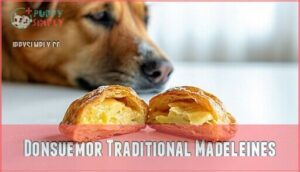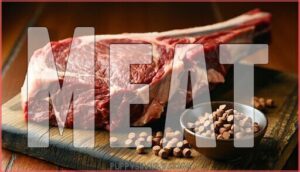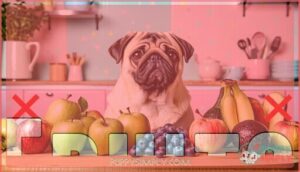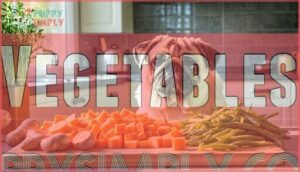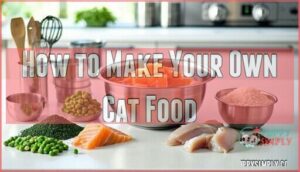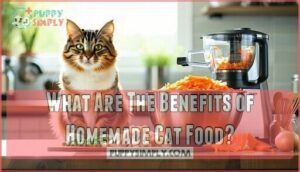This site is supported by our readers. We may earn a commission, at no cost to you, if you purchase through links.

While plain madeleines might seem harmless, they’re packed with sugar, butter, and eggs that offer zero nutritional value for dogs.
The real concern comes with flavored varieties that might contain chocolate or xylitol, both toxic to canines.
Even "safe" madeleines can cause digestive issues, obesity, and dental problems when given regularly.
Think of it this way: what tastes like heaven to you might spell trouble for your four-legged friend.
Understanding which specific ingredients pose the biggest risks can help you make smarter treat choices.
Table Of Contents
- Key Takeaways
- What Are Madeleines?
- What Are The Ingredients in Madeleines?
- Are Madeleines Healthy for Dogs?
- When Shouldn’t You Feed Madeleines to Your Dog?
- Canine-friendly and Safe Alternatives to Madeleines
- How to Make Your Own Cat Food
- What Are The Benefits of Homemade Cat Food?
- Is Homemade Cat Food Safe?
- Is Homemade Cat Food Better for Senior Cats?
- Is Raw Food Diet Safe for Cats?
- Frequently Asked Questions (FAQs)
- Conclusion
Key Takeaways
- Don’t feed madeleines to your dog – these French butter cakes contain high amounts of sugar, fat, and calories that can cause digestive upset, obesity, and pancreatitis in dogs
- Watch out for toxic ingredients – flavored madeleines may contain chocolate or xylitol, both of which are poisonous to dogs and can cause serious health complications
- Skip madeleines if your dog has health issues – dogs with diabetes, obesity, pancreatitis, or lactose intolerance shouldn’t eat these treats as they’ll worsen existing conditions
- Choose safer alternatives instead – offer your dog lean meats, fresh fruits like apples or bananas, vegetables like carrots, or fish rich in omega-3 fatty acids for healthier treat options
What Are Madeleines?
What are madeleines, exactly? They’re French sponge cakes with a shell shape, made from enriched flour, butter, and other ingredients.
Originating from France, madeleines have cultural significance and variations. The baking process gives them a moist texture.
You’re likely familiar with traditional madeleines, but have you considered their ingredients and potential impact on your dog’s health, especially in terms of traditional madeleines?
What Are The Ingredients in Madeleines?
You’re probably wondering what’s in madeleines that could be harmful to your dog.
As you check the ingredients, you’ll find that madeleines typically contain high amounts of sugar, fat, and calories, which can be detrimental to your dog’s health.
Starbucks Madeleines
You’re considering Starbucks Madeleines for your dog.
These treats contain 126.3 calories, 10.4g sugar, and 6g fat per 28g serving.
With high sugar and fat content, they pose risks like toxicity and obesity.
As a dog owner, it’s vital to weigh the calorie content and sugar impact, considering madeleine ingredients and potential madeleine toxicity dogs may face, to decide if can dogs eat madeleines safely.
Starbucks Madeleines Recipe
You’re looking at the Starbucks Madeleines Recipe, which includes wheat flour and sugar.
Key points to keep in mind:
- Ingredient Substitutions
- Baking Techniques
- Nutritional Concerns
- Serving Suggestions
- Toxicity risks, as can dogs eat madeleines is a concern due to madeleine ingredients and risks.
The main concern is the ingredients and their potential impact on health, especially for pets.
Donsuemor Traditional Madeleines
When examining Donsuemor Traditional Madeleines, consider the ingredient analysis, revealing 130 calories and 10g of sugar per serving.
As a dog treat, this sugar content and fat composition pose health risks, particularly for dogs with dietary restrictions.
Compare brands and prioritize dog health, avoiding toxic foods.
Donsuemor Madeleines Recipe
When whipping up Donsuemor madeleines at home, you’ll want to understand which ingredients pose risks to your furry friend.
Here are three key recipe modifications for safer baking:
- Sugar reduction – Cut sweetener amounts substantially
- Butter alternatives – Consider healthier fat substitutions
- Storage recommendations – Keep finished madeleines away from curious paws
These ingredient substitutions help minimize madeleine toxicity concerns for dogs.
Are Madeleines Healthy for Dogs?
You might wonder if madeleines can be a healthy treat for your furry friend, but the answer isn’t what most dog owners hope to hear.
These sweet French cakes pack high amounts of sugar, fat, and calories that can harm your dog’s health rather than help it, making them an unhealthy option with potentially harmful effects.
Sugar
Sugar packs a punch in regards to dog health risks, and madeleines don’t hold back.
Too much sugar can trigger canine diabetes, dental health problems, and dog obesity.
While sugar alternatives exist, they’re not always safe sweeteners for your furry friend.
Sugar toxicity isn’t just about weight gain – it affects your dog’s entire system.
Before sharing that sweet treat, remember that toxic foods dogs should avoid often hide behind innocent appearances.
Starbucks Madeleines Calories
A single Starbucks madeleine packs quite a caloric punch for your furry friend.
These seemingly innocent treats deliver concerning numbers that could impact your dog’s health:
- 126.3 calories – that’s significant for smaller dogs
- 6g fat content – contributing to potential weight gain
- 10.4g sugar levels – risking digestive upset and diabetes
Consider these serving sizes before sharing this sweet indulgence.
Nutritional Profile of Starbucks Madeleines (28g)
Let’s break down what’s actually inside that 28g Starbucks madeleine your dog’s eyeing.
The calorie breakdown shows 126.3 calories packed into a small serving – that’s like giving your pup a calorie bomb.
Here’s the ingredient analysis that’ll make you think twice:
| Component | Amount | Health Concerns |
|---|---|---|
| Total Fat | 6g | Pancreatitis risk |
| Sugar | 10.4g | Diabetes, obesity |
| Protein | 1.1g | Minimal nutritional value |
These macronutrient ratios spell trouble for dogs.
Donsuemor Madeleines Calories
When checking Donsuemor Madeleines’ calorie source, you’ll find each 28g piece packs 130 calories—that’s substantially more than other brands.
The fat content hits 7g per serving, while sugar impact reaches 10g, creating serious health risks for your furry friend.
These ingredient concerns make Madeleines unsuitable snacks for dogs, as the high calorie density can quickly lead to weight gain and digestive issues.
Consider safe alternatives like carrots or apple slices instead.
Nutritional Profile of Donsuemor Traditional Madeleines (Per Piece or 28g)
Looking at the calorie breakdown for Donsuemor Traditional Madeleines, each 28g piece packs 130 calories—that’s a significant chunk for your furry friend.
The fat content hits 7g per serving, while sugar impact reaches 10g, making these treats quite rich.
Protein value sits at just 2g, offering minimal nutritional benefit.
When you examine the ingredient analysis, you’ll find enriched flour, butter, and sugar dominating the recipe.
For small breeds like Chihuahuas, even half a madeleine could spell trouble due to excessive calories and sugar.
When Shouldn’t You Feed Madeleines to Your Dog?
You shouldn’t feed madeleines to dogs with existing conditions like diabetes, obesity, or pancreatitis.
Skip the sweet treats if your pup has diabetes, obesity, or pancreatitis—their health trumps that fleeting tail wag.
These treats pack dangerous levels of sugar and fat that worsen weight concerns and trigger health crises.
Puppies are especially vulnerable to madeleine toxicity due to their developing systems.
Dogs with lactose intolerance will suffer digestive upset from butter and milk ingredients.
Some madeleines contain toxic ingredients like certain spices or chocolate chips.
When your furry friend has any health issues, skip these toxic foods entirely—their wellbeing isn’t worth the risk.
Canine-friendly and Safe Alternatives to Madeleines
When you’re looking for healthier treats that won’t put your furry friend at risk, you’ll find plenty of nutritious options that taste great without the sugar and fat overload of madeleines.
Simple choices like lean meats, fresh fruits, vegetables, and omega-3 rich fish provide essential nutrients while keeping your dog’s tail wagging and their health on track.
Fish
Fish makes an excellent alternative to sugary madeleines, offering your dog valuable omega-3 fatty acids that support coat health and reduce inflammation.
However, smart fish preparation is vital for safety.
Here are key fish benefits and considerations:
- Fish Types: Salmon, sardines, and mackerel provide the most omega-3s, while avoiding high-mercury fish like tuna
- Fish Preparation: Always cook fish thoroughly and remove all bones to prevent choking hazards
- Fish Risks: Watch for fish allergies and limit portions to prevent digestive upset
Remember, fish should complement your dog’s regular diet, not replace balanced dog treats designed for ideal pet nutrition.
Many owners supplement with additional omega 3 for superior health.
Meat
Lean meats like chicken and beef make excellent protein sources for your furry friend.
Cook thoroughly to avoid raw meat risks and potential meat allergies. Skip fatty cuts and bones that could spell trouble.
These wholesome dog treats beat toxic foods dogs should avoid, supporting ideal dog nutrition and overall dog health tips while preventing dog poisoning incidents.
Many owners choose to buy pre-packaged options for convenience.
Fruits
Sweet treats don’t have to come from the bakery when you’ve got nature’s candy at your fingertips.
Safe fruits like apples (seeds removed), bananas, blueberries, and strawberries make excellent healthy dog snacks packed with vitamins and antioxidants.
However, toxic fruits including grapes, cherries, and citrus can seriously harm your pup.
When preparing fruit treats, wash thoroughly and remove pits or seeds. Keep serving sizes small—a few pieces work perfectly as dog treats.
Always research before sharing safe human food with your furry friend. While fruit snacks might seem appealing, remember that xylitol is toxic to dogs.
Vegetables
Vegetables pack a nutritional punch for your furry friend, offering safe alternatives to sugary madeleines.
These colorful options provide essential vitamins while satisfying your dog’s craving for variety.
- Carrots – Crunchy, low-calorie treats rich in beta-carotene
- Green beans – Fiber-packed snacks that support digestive health
- Sweet potatoes – Natural energy boosters loaded with vitamins
- Broccoli – Antioxidant powerhouses (serve in small portions)
How to Make Your Own Cat Food
If you’re considering homemade meals for your feline friend, you’ll need to understand proper nutrition before switching from commercial cat food.
Making your own cat food requires careful planning to guarantee your cat gets all essential nutrients, including proteins, vitamins, and minerals that support their health.
First Things First
Starting with homemade cat food isn’t rocket science, but initial considerations matter most.
You’ll want to gather veterinary advice before switching from store-bought options.
Making your own saves money and controls ingredients better than commercial treats.
Many owners find success using specialized food recipes.
Don’t get discouraged if your first attempts aren’t perfect—even experienced pet owners stumble initially.
Patience pays off when creating safe alternatives to commercial food, and with persistence, you can develop a successful homemade cat food regimen.
What’s in a Balanced Diet?
Creating a balanced homemade cat diet requires understanding your feline’s unique nutrient requirements.
You’ll need quality protein, healthy fats, and proper calorie intake management. While this article focuses on dog dietary needs, cats share similar hydration importance and portion control principles.
Essential ingredients for balanced cat nutrition:
- 1 pound lean ground chicken – provides complete protein your cat craves
- Coconut oil and sardines – deliver healthy fats for shiny coat
- Fresh water or bone broth – supports hydration importance and digestive health
Adjustment Periods
Your cat might turn their nose up at homemade food initially—that’s completely normal.
Some cats embrace dietary changes immediately, while others need patience.
Start with small portions alongside their regular food, watching for digestive issues like upset stomach or loose stools.
Gradual introduction works best, mixing increasing amounts over several days.
Monitor behavioral shifts during this period, as stress can affect appetite.
If you notice concerning symptoms or madeleine toxicity dogs might face, veterinary monitoring guarantees your pet’s safety throughout the adjustment process, ensuring complete safety.
Supplements for Homemade Cat Food Diets
Often overlooked, Essential Vitamins like B-complex and Vitamin E are vital for homemade cat food.
You’ll need Taurine Importance for heart health, Omega Fatty Acids from fish oil, and proper Mineral Balance.
Consider Probiotic Benefits too. When crafting raw food diet recipes, these supplements bridge nutritional gaps that meat alone can’t fill, ensuring your feline friend thrives.
What Are The Benefits of Homemade Cat Food?
Making your own cat food offers several compelling advantages that go beyond just filling your feline’s bowl. Ingredient Control stands as the primary benefit – you’ll know exactly what goes into every meal, eliminating mystery additives and preservatives.
This transparency becomes vital for Allergy Management, allowing you to avoid specific proteins or grains that trigger your cat’s sensitivities. Cost Savings can add up substantially over time, especially when feeding multiple cats or managing chronic health conditions requiring specialized diets.
For Picky Eaters who turn their noses up at commercial options, homemade cat food lets you customize flavors and textures to match their preferences. The preparation process creates a unique Bonding Opportunity between you and your cat.
Working with a veterinary nutritionist helps your homemade recipes maintain a proper nutritional profile and balanced diet, whether you’re preparing cooked meals or considering a raw food diet approach.
Is Homemade Cat Food Safe?
When preparing homemade cat food, safety isn’t guaranteed just because you’re cooking at home. You’ll face real challenges that commercial pet food manufacturers have already solved through strict recipe regulations and quality control.
Nutrient deficiencies top the list of concerns. Cats have specific nutritional needs that differ drastically from dogs or humans. Without proper formulation, your well-intentioned meals might lack essential vitamins, minerals, or amino acids.
This creates long-term effects that won’t show up immediately but can damage your cat’s health over time. Foodborne illnesses present another serious risk. Raw food diets especially increase bacterial exposure, potentially causing dangerous infections.
Even cooked homemade cat food requires careful ingredient sourcing and proper food handling to prevent contamination. Creating a truly balanced diet demands extensive nutritional knowledge. Most pet owners underestimate this complexity.
Considering essential nutrients for dogs is vital even in preparing cat food, as some overlap in nutritional needs exists. While homemade food can work, it requires veterinary guidance, precise recipes, and consistent monitoring to safeguard your cat’s safety and health.
Is Homemade Cat Food Better for Senior Cats?
Senior cat nutrition becomes increasingly important as your feline friend ages, and homemade cat food can offer significant advantages over commercial options.
Your senior cat deserves nutrition that ages as gracefully as they do.
Creating meals designed to meet your senior cat’s specific nutritional needs allows you to control ingredients while avoiding fillers and preservatives that might upset their sensitive digestive systems.
Here are three key homemade food benefits for aging cats:
- Customized protein levels – You can adjust meat portions based on kidney function and activity levels
- Enhanced digestibility – Fresh, lightly cooked ingredients are gentler on older stomachs than processed kibble
- Medication integration – Pills and supplements blend seamlessly into homemade meals
A balanced diet for senior cats requires careful planning with supplement considerations and diet adjustment tips from your veterinary nutritionist. Considering the AAFCO standards can guarantee nutritional balance. They’ll help guarantee your homemade recipes meet all essential requirements while addressing age-related health concerns like arthritis or kidney disease.
Is Raw Food Diet Safe for Cats?
Why risk your cat’s health with a raw food diet when safer alternatives exist? Raw food diets carry significant bacterial contamination risks, including salmonella and E. coli exposure that can seriously harm your feline friend.
While raw diet benefits include fresher ingredients, the raw diet risks often outweigh these advantages.
| Raw Diet Benefits | Raw Diet Risks |
|---|---|
| Fresher ingredients | Bacterial exposure |
| Natural enzymes | Nutritional imbalance |
| Palatability for some cats | Food poisoning potential |
| Owner control over ingredients | Incomplete nutritional profile |
Nutritional completeness becomes challenging without proper knowledge. Many homemade cat food recipes lack essential nutrients cats need. Senior cats especially require balanced nutrition that’s difficult to achieve through raw feeding.
A potential benefit to raw diets is that they can provide more bioavailable nutrients for improved health. Before considering any raw food diet, veterinary consultation is absolutely essential. Your vet can assess whether raw feeding suits your cat’s specific needs and help you understand the bacterial contamination risks involved.
Frequently Asked Questions (FAQs)
Can dogs eat clementines?
Like finding treasure in your fruit bowl, clementines can be a sweet treat for your dog.
You can share small peeled segments occasionally, but remove all seeds and pith to avoid digestive upset, which makes clementines a great option when prepared correctly.
Can dogs eat noodles?
You can give your dog plain, cooked noodles occasionally as they’re not toxic, but they offer little nutritional value.
Avoid noodles with garlic, onion, or heavy sauces, which can harm dogs.
Can dogs eat ugli fruit?
Sweet as sunshine, ugli fruit is generally safe for your dog in small amounts.
Remove seeds and peel first—they’re choking hazards.
The citrus can upset sensitive stomachs, so start tiny and watch for reactions.
Can dogs eat tangerines?
Dogs can eat tangerines in small amounts, but you’ll want to remove seeds and peel first.
The citrus might upset sensitive stomachs, so start with tiny pieces and watch for any digestive issues.
Can a dog eat pasta?
Think of pasta as a blank canvas – it’s what you add that matters.
Plain, cooked pasta won’t harm your dog, but you’ll want to skip the garlic, onions, and rich sauces that make it dangerous.
Can dogs eat people food?
You can share some people food with your furry friend, but it’s not a free-for-all.
Stick to dog-safe options like plain chicken, carrots, or apples while avoiding chocolate, grapes, and onions completely.
Are madeleines okay for dogs?
Madeleines aren’t ideal for your pup.
They’re packed with sugar, butter, and calories that can trigger pancreatitis, obesity, and digestive upset.
Skip the fancy French treats and offer dog-safe alternatives instead.
What pastry can dogs eat?
While you might think all pastries are off-limits, dogs can safely enjoy plain treats.
Dogs can enjoy these treats made with dog-friendly ingredients like pumpkin, oats, and peanut butter—avoiding sugar, chocolate, and artificial sweeteners completely.
What are the risks of feeding a dog baking powder?
Feeding your dog baking powder poses serious risks.
Large amounts can cause toxicity, leading to seizures, disorientation, and muscle tremors.
Even small doses may trigger vomiting and digestive upset in sensitive pups.
Is canola oil safe for dogs to consume?
Ironically, what’s marketed as "healthy" cooking oil isn’t ideal for your pup.
Canola oil won’t poison your dog, but it’s highly processed and potentially GMO-sourced.
Stick with olive oil for better nutrition instead.
Conclusion
Like a caring parent who wouldn’t share their coffee with a toddler, you shouldn’t share madeleines with your dog.
These buttery French treats aren’t designed for canine digestive systems and can cause serious health issues. While one small bite won’t kill your pup, the sugar, butter, and potential toxic ingredients make them poor choices.
Can dogs eat madeleines safely? The answer is no. Instead, stick to dog-specific treats that’ll keep your furry friend healthy and happy.




